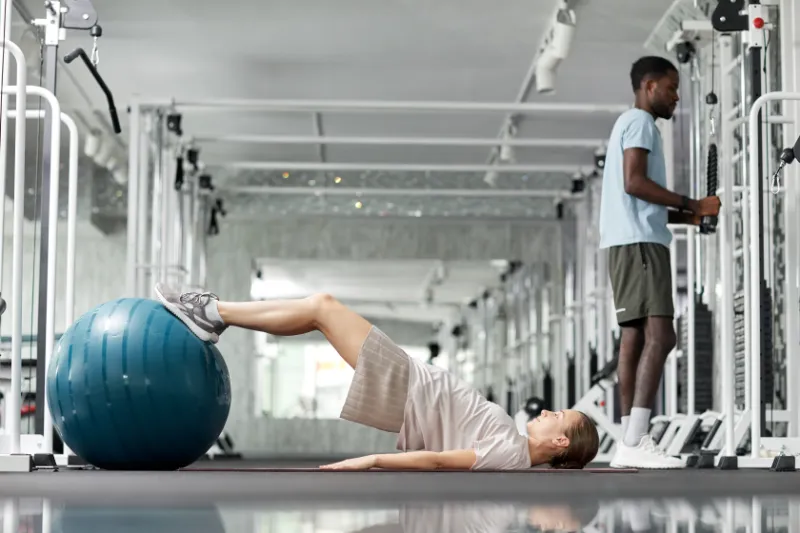What’s the score with the pelvic floor?

Written by Emily Elgar (Women’s Health Specialist)
Whilst most people have been told they should practice pelvic floor exercises, many don’t know why, how or how many. Your pelvic floor may feel like a faithful friend or as elusive as a unicorn but read on to find a way to a healthier pelvic floor and a happier you!
Patients and friends have told me many things about the pelvic floor from the bizarre (oh I can’t do those, I can’t get down on the floor!) to the harmful (Yes, pelvic floors- I do them every time I wee Stop, Start, Stop, Start, Stop- argh NO NO NO I cry!). What has been advised has changed a lot over the years and I’m proud to be a part of a women’s health community that is elevating the importance of a properly functioning pelvic floor. I’ll give you a hint it’s more than just squeezing it!
Before we go any further let’s talk anatomy- now don’t skip this bit. I believe if you know why you’re doing something you’re much more likely to do it. The pelvic floor is made up of three layers each having a different role. The outer part of your pelvic floor is related to sexual function, whilst the deeper layers work to support and control the pelvic organs. The muscles and connective tissue (called fascia) anchor from the ring shaped pelvis to work together to achieve these functions. Often it is likened to a trampoline (even though that may be your nemesis!) however I explain it to my patients as layered ‘horseshoes’. These horseshoes attach along the front and side of your pelvis (the inner side of your groin) and loop back around your pelvic organs- bladder neck, bowel and vagina for women. If you imagine that as your muscles tighten these horseshoes shorten creating a lift and closure around the openings.
Before we get stuck in I want you to remember your anatomy and make sure your bottom, shoulders or eyebrows don’t join in- we know the muscles don’t start from there! There are two types of exercises: 1) Holds and 2) Short squeezes. I’m going to introduce you to my ‘Wink & Zip’ method to do ‘holds’. If you follow these simple principles, you’ll improve the quality of your practice. Firstly focus just on your back passage imagining you feel the urge to pass wind. Can you squeeze to make a ‘wink’ as if you were holding on (this is great training if you struggle with those sneaky little trumps that come by surprise). As you wink with your back passage try to bring your tailbone forward as if you were lifting it up and in. Next visualise a trouser zip that starts at your back passage and runs all the way to your lower tummy. Continue this squeeze forward to your front passage as if you were closing that zip. You may feel as you do this a gathering of your lower tummy muscles- this is fine just make sure you can still feel your pelvic floor working. Test your pelvic floor by holding this for a complete in and out breath. Many ladies I treat struggle to do this and will also report leakage with a cough, a sneeze and when running. If you have also noticed this, try making sure you can hold your pelvic floor and complete this breathing exercise to help improve how these muscles co-ordinate. Lastly to increase your squeeze, picture the corners of your pelvis where your hip joints are. Link all four points up (left hip, front passage, right hip and pack passage/tailbone) to create a diamond shape. As you squeeze, draw equally from each of these points shrinking that diamond. As you do all of this you should feel a tightening &/or lifting inside your groin.
Short squeezes require only a brief contraction as if switching on a light. This time imagine the centre of the diamond (over the skin between your vagina and back passage or behind your scrotum) being lifted and pinched then release completely. Even though this is quicker make sure the effort is predominantly in your groin rather than allowing your upper abdominals to brace. The relaxation of the muscles between each squeeze is important to make sure you are training the sudden quick response needed as if you were sneezing. For most people if you are doing your exercises properly and frequently enough (3 times a day for up to 10 repetitions of both short squeezes and long holds) your muscles should improve their control and strength in 6-12 weeks. I know all that might seem a long time but if it stops leakage, prevents or reduces prolapse and heightens sexual pleasure then I think that’s a solid gold sales pitch!
So many of my patients feel lost with their pelvic floor, if you have tried what I have suggested above and are still struggling with symptoms of leakage (amongst other pelvic floor problems) then please I urge you to seek help here in our clinic. There are lots of reasons why you may be struggling and plenty that can be done to help you. I passionately believe the joy in our lives shouldn’t be robbed by our pelvic floor.
If you would like to book in to see Emily here at Katie Bell Physiotherapy and Wellness please contact reception on either hello@katiebellphysio.com or 01143272080 and we can arrange an appointment for you.

